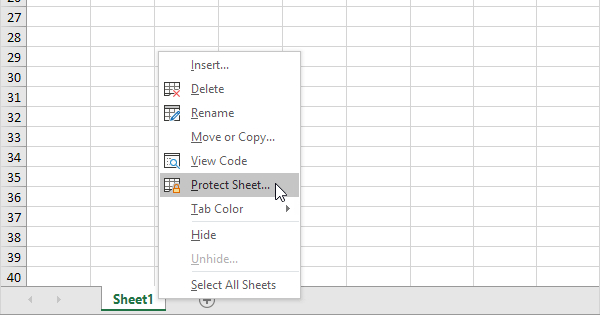Protecting Your Excel Sheets: A Simple How-To Guide

Securing Your Data with Excel Sheet Protection

If you work with Microsoft Excel for managing financial models, tracking sales data, or any sensitive information, ensuring that your sheets are secure is paramount. Excel offers several features to help protect your workbooks and sheets from unintended changes or prying eyes. Let's dive into how you can effectively use these tools to safeguard your Excel files.
Why Protect Your Excel Sheets?

Before we delve into the mechanics of protecting your Excel sheets, understanding why you should protect your data is crucial:
- Prevent Unauthorized Changes: Ensure that only authorized users can make modifications to your data.
- Preserve Data Integrity: Protect formulas, critical data, and the structural integrity of your sheets.
- Maintain Confidentiality: Keep confidential information secure by limiting who can view or edit certain parts of the workbook.
Steps to Protect an Excel Sheet

To begin protecting your Excel sheets, follow these steps:
1. Worksheet Protection
Here's how you can protect an individual worksheet:
- Select the worksheet you wish to protect.
- Go to the Home tab on the Ribbon, then click on the Format dropdown in the Cells group, and select Protect Sheet... or use the Review tab and choose Protect Sheet under Changes.
- In the dialog box that opens, you can:
- Set a password to unprotect the sheet.
- Choose which actions users can perform like selecting locked cells, formatting cells, etc.
2. Workbook Protection
To protect the entire workbook, which prevents users from adding, moving, or deleting sheets:
- Navigate to the File tab, click on Info, and then select Protect Workbook.
- Choose Encrypt with Password to add a password for opening the workbook, or Protect Structure and Windows to prevent sheet manipulation.
- If you choose structure protection, you can set a password in the Protect Structure and Windows dialog box.
💡 Note: Remember your passwords, as there is no way to retrieve them if you forget.
Advanced Protection Techniques

Cell-Level Protection
Here's how you can lock specific cells to prevent changes:
- Select the cells you want to lock or unlock.
- Right-click and choose Format Cells, or use the shortcut Ctrl+1.
- In the Protection tab, ensure Locked is checked or unchecked according to your needs. By default, all cells are locked, but this doesn't take effect until you protect the worksheet.
Hiding Formulas
To hide formulas:
- Follow the steps for cell-level protection.
- Under the Protection tab, select Hidden.
- Protect the sheet as described above.
Using VBA for Enhanced Protection
For those familiar with Visual Basic for Applications (VBA), you can automate protection:
Sub ProtectSheet()
With ActiveSheet
.Protect Password:="YourPassword", DrawingObjects:=True, Contents:=True, Scenarios:=True
.EnableSelection = xlNoSelection
End With
End Sub
🛠️ Note: Using VBA requires enabling macros, which could pose a security risk if the workbook is shared publicly.
Key Considerations for Protecting Excel Sheets

When you protect your Excel sheets, here are some key points to remember:
- Backup: Always create a backup of your workbook before applying protection.
- Sharing: When sharing protected files, inform users about any restrictions or permissions.
- Audit: Consider implementing an auditing feature to track changes, especially if protection is critical.
Remember, while protecting your Excel sheets adds a layer of security, it's not foolproof. More sophisticated users might still bypass protection using methods like VBA code or external tools. Therefore, ensure that the level of protection aligns with your data's sensitivity.
By following these steps, you can keep your Excel sheets secure from unauthorized changes while maintaining the usability for legitimate users. Whether for personal use, business operations, or collaborative projects, Excel's protection features can help maintain the integrity and confidentiality of your data.
What happens if I forget the password to my protected Excel sheet?

+
If you forget the password, there’s no straightforward way to unlock the sheet without using third-party tools or guessing the password. Always keep a record of your passwords.
Can I still edit cells in a protected sheet?

+
Yes, you can unlock specific cells before protecting the sheet, allowing users to edit those cells while keeping others protected.
Is protecting an Excel sheet different from protecting an entire workbook?

+
Yes, sheet protection locks individual worksheets, while workbook protection safeguards the structure (e.g., adding, deleting sheets) and can encrypt the file with a password.